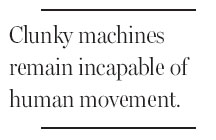Umbilical link of man to robot
Updated: 2013-11-03 08:12
By John Markoff(The New York Times)
|
|||||||||
WORCESTER, Massachusetts - Atlas doesn't shrug. But he teeters, loses his grip, stutters and staggers.
His task one afternoon is to clear a debris field. After many agonizing moments, in a set of abrupt and jerky movements, he crouches and with painstaking precision manages to grasp a piece of wood and then drop it to his right. At the rate he is moving, completing the chore might take days.
Atlas in this case is an imposing, 1.8 meter-tall humanoid robot. It stands in a cluttered robotics laboratory here at Worcester Polytechnic Institute where a team of students, engineers and software hackers are training the 150-kilogram bundle of sensors, computers, metal struts, joints and cables.
Seven teams are working with Atlas robots, manufactured by Boston Dynamics. Like the others, the Worcester team is preparing for a December contest held by the Pentagon's Defense Advanced Research Projects Agency. The contest is meant to accelerate work in the field of robotics by making prototypes that can work effectively and autonomously in extreme emergencies, like the failure of a nuclear power plant.
Atlas remains tethered. Like a toddler learning to walk, it wears a safety harness, and whenever it moves, its human operators position themselves behind a transparent plastic enclosure.
The care is warranted. If the robot did keel over, it would be like a car crash.
And with each Atlas valued at roughly $2 million, the roboticists are going to elaborate lengths to make sure that doesn't happen.
While there are smaller and lighter autonomous robots like Honda's Asimo, or the South Korean Hubo, that do move around unaided, it is nearly certain that Atlas will never wander freely among humans. Each of its arms weighs a dozens or so kilograms.
And when Atlas works, it howls. A hydraulic compressor screams at a decibel level just below regulation safety limits.
One member of the team holds the belay rope, and another stands guard by an emergency stop button, while the robot controller sits in front of a large computer screen. It displays a 3-D image, called a "point cloud," that is generated by the robot's laser range finder, which measures distance and maps objects.

With a keyboard and a mouse, the operator can issue commands to the robot, from walking to more incremental movements like opening and closing the three fingers of the machine's hand.
In December, teams will compete on a set of tasks like driving, closing a valve, crossing a rubble field and climbing a staircase. A year later they will compete at more complex tasks for a $2 million prize. "We've only had two or three months to play with our toys," said Chris Atkeson, a robotics professor at Carnegie Mellon in Pittsburgh, Pennsylvania.
The teams' success will be determined largely by how well they program autonomous skills in the robots in the coming months. Mr. DeDonato, for example, said he was envious of another campus team, which in cooperation with Drexel University in Philadelphia is programming a Hubo robot. That team has a sophisticated algorithm designed by the W.P.I. roboticist Dmitry Berenson, making it possible for the robot to use both arms simultaneously to close a valve. "I wish we had that code," Mr. DeDonato said.
For its part, Atlas would probably shrug - if only it could. Suspended in the lab and awaiting its controller's digital commands, it is also missing the shoulder joint necessary for that motion.
The New York Times
(China Daily 11/03/2013 page11)